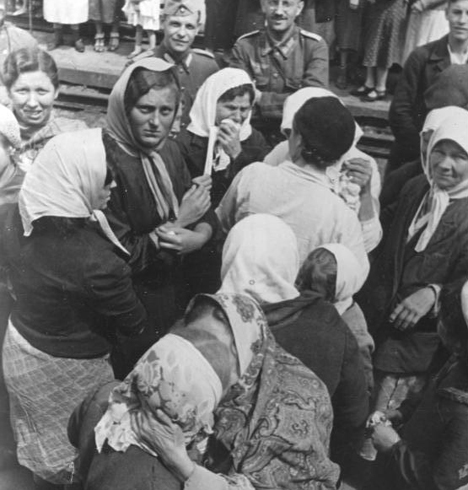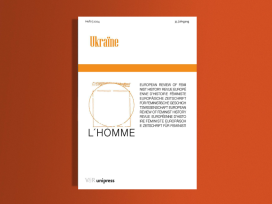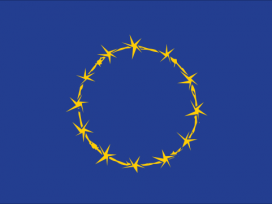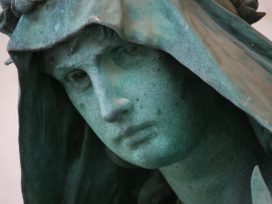That millions of foreign workers were deported from German-occupied Europe during the Second World War, and forced to work in factories, industry and agriculture on Third Reich territory or beyond, has become one of the least-remembered chapters of German migration history. Zwangsarbeit (forced labour) barely features in German collective memory of the period and took much longer than other Nazi crimes to find even some degree of restitution. When former forced labourers living in the USA filed suits against German companies, the German taxpayer and industrial sector rather grudgingly shared the costs of some five billion euro. By June 2007, the money had been paid to a total of 1.5 million victims or their heirs.

Forced labourers in Nazi Germany. Photo: Deutsches Bundesarchiv. Source: German Federal Archives
Why did it take so long to redress the crime? Why was it done with such bad grace? Why is it so difficult, in general, to remember the facts of forced or even voluntary migration into Germany? When an official commemoration for immigrants murdered by neo-Nazis took place in Berlin in February 2012, why were many Germans almost shocked to be reminded that the history of migration stretched back well over a hundred years? One explanation would certainly be that historical research lacks the necessary sources, that there are methodological problems, and that historians hardly see migration as a field with career prospects. However, I think that there are three deeper symbolic dimensions to the problem, which are simultaneously cornerstones of European collective identity and its dark side: the disciplinary nature of industrial work, the fear of “nomads” with no fixed abode, and white racism.
Legacies of the disciplinary society
The subject of Zwangsarbeit has met with a great deal of resistance and wariness – from both victims and perpetrators. In post-Nazi Germany, the main reason for this was that slave labour was a public crime, organized by the state but welcomed and supported by the nation at large, who – following a long and ignoble tradition – believed that it would rehabilitate the “workshy”. In recent years, the foundation “Remembrance, Responsibility and Future” (Stiftung EVZ) has been working to explain and commemorate this episode of German history, making a wider public aware of it. Less well-known is that there is an equal and opposite taboo on the other side. A great many forced labourers came from the Soviet Union; after 1945, survivors ended up in Soviet “filtration camps”. Like Soviet prisoners-of-war, deportees were stigmatized as “traitors” and very often ended up in the Gulag, a pillar of Soviet communism’s repressive apparatus. Slave labour had underpinned the forced industrialization under Lenin and Stalin: prior to 1941, millions of “class enemies”, along with members of proscribed ethnic and religious minorities, had been deported to the camps of the “Gulag Archipelago”. Their number was added to by the hundreds of thousands of German POWs and civilians sent to Sibiria from Soviet-occupied regions during and after the Second World War. A large part of them died from starvation, sickness, overwork, cold and the unhygienic conditions in the camps and on the transports.
These “corrective labour camps” were a continuation of precursor policies in Tsarist Russia, yet their existence was officially denied – a secret that hung over the heads of Soviet citizens like the sword of Damocles and which could claim their lives if they made the smallest slip, or suffered spiteful denunciation. The subject only came to be debated during the post-Stalinist thaw, above all in the fiction and essays of Alexander Solzhenitsyn. Even today, the work of documenting the camp system is incomplete; nor have perpetrators been brought to justice, or a line drawn under that part of the past. The myth of the sacrifices made during the Great Patriotic War meant that even those affected by Stalin’s repression colluded in making the topic taboo.
Germany did not fully begin to make reparations until 2000 (by which time most former deportees were either dead or very old); in Russia, victims have not received even rhetorical justice. This reluctance can be explained by the noxious tradition of penal labour that dominated both totalitarian systems between 1930 and 1960, regardless of ideological differences. However, forced labour also relies on an older and deeper layer in European society, a tradition of labour as discipline and means of control. The workers’ movement, with its goal of solidarity, was never entirely able to overcome this pernicious legacy. Today, when the public debate about migration often seems in danger of focusing only on utility (and, implicitly, on “uselessness”), this disciplinary tradition needs to be borne in mind.
These taboos stifle and distort attempts to write the history of the migrant workers, the Gastarbeiter (guest workers), who came more willingly than the Fremdarbeiter (foreign workers) during the war, but who were nevertheless subject to other sorts of pressure. The blurring of the line between forced and voluntary labour has become more widespread with the globalization of the labour markets, which cannot emerge without drastic suffering in the world’s poorest regions and urban agglomerations, and where the workforce is often subject to what amounts to slavery.
Taboos also affect other groups in migration history: despised ethnic minority groups with a tradition of travelling, such as the Roma and Sinti, asylum-seekers and refugees, those who find themselves called “migrant workers” even when their family has lived in the country for four generations. At a few locations in Europe, museums of migration have documented in detail the various origins of migrant flows and the reasons for them – which are always some combination of necessity and free will. Indeed, we may even say that these days we no longer need museums of migration, since in many of the most densely-populated regions of Europe, having immigrant roots is entirely normal and “commemoration” can no longer be hidden away in special museums. When parts of the population are called “problem groups”, this isn’t because they are problematic per se, but because they pose problems for the majority, calling into question Europe’s own self-image and provoking the same defensive reaction as did forced labour.
Public opinion in liberal societies with high immigration levels has generally been unwilling to admit the connections and continuities between the forced labour of the totalitarian regimes of the twentieth century (and their authoritarian, nineteenth-century predecessors) and the voluntary labour migration of today. It is important to explain the effects of global inequality on deregulated labour markets in the North, not least because demographic changes in these countries will only lead to more demand for skilled and unskilled labour. The criteria of utility and social discipline will come to play a large role, with widespread xenophobia and racist attitudes ever present in the background. At the same time, the transnationalization of labour markets, together with societal breakdown, widening social divisions and ecological problems and disasters in the global South, will probably increase levels of migration.
Fear of the nomadic
Ethnic discrimination in Europe did not come to an end in 1945. In many towns and villages in eastern Europe, neighbourhood groups and local councils have erected fences and walls around so-called “Gyspy quarters”, seeing this as the only way to protect themselves against anti-social behaviour and theft for which the Roma are so often blamed. In Slovakia, where Roma make up around ten per cent of the population, “Gypsy ghettos” are forming; twenty years after the fall of the Iron Curtain, new walls are being erected, in the heart of Europe, and against a European people. Similar measures have been taken in the Czech Republic, Romania, Bulgaria and Hungary, where Roma are subject to systematic discrimination and social exclusion. The end of the socialist economy was a catastrophe for the Roma, given that the great majority of them were employed in the state-run agricultural sector. When this was privatized, they lost their jobs and moved from the countryside to the “Gypsy quarters” (the mahalas) in the towns and cities.
In western Europe too, where most Roma have lived a settled life for centuries, they have remained a fly in the social ointment. Again and again, Roma experience conflict with neighbours and the police, have their encampments searched, are told to move on, whether or not they have the proper approval. The situation escalated in Italy and France in the summer of 2010, when the governments of both countries instituted a deliberate policy of breaking up Roma camps, risking serious conflict with the European Commission. There are very few countries in the EU where Roma can live free from prejudice – which ranges from verbal abuse to full-blown official harassment – even though they are EU citizens and thus, as the French case showed, cannot easily be deported.
The Gypsies’ marginal role has less to do with their origin than with their status, even though they are actually a perfect embodiment of Europe’s social mobility. This harks back to the ancient division between settled farming peoples (gadjo in Romani languages) and nomads. In agrarian societies, nomadic and semi-nomadic people were usually feared, since such “masterless men” did not fit the patterns of collective identity established by ethnic belonging and ties to a settled, local landscape. It seems likely that such perceptions have lasted into post-agrarian societies, even though (or possibly because) such societies have given rise to new forms of nomadism, to transnational lives and lifestyles, particularly the highly mobile workforce at the very top and very bottom of the payscale. Further grounds for intolerance and exclusion are that the Roma live in patriarchal family and clan structures, that these households run their own affairs in a very close-knit manner, and that they observe ritual purity laws. In the folklore, the Roma are seen as exotic and strange, refusing to adopt majority norms, and generally dangerous; even the more benevolent view of the Roma as musical virtuosi, passionate flamenco dancers and devout pilgrims (for instance in the annual pilgrimage to Sainte-Marie-de-la-Mer in the Camargue) is loaded with patronizing and marginalizing assumptions. As with the Jewish minority in Europe, governments and majority populations have, at various times, either imposed limits on Roma people’s mobility or forced them to migrate, aggressively targeting those who suffer most from the status quo. All of this despite the evident fact that the overwhelming majority of Roma are settled, and that the proportion of truly “nomadic” Roma is constantly dwindling.
Even though the great majority of Roma are citizens of the country in which they live, or possess the legal residency papers, we may metaphorically say that they are a stateless group. The Roma are Europe’s pariahs and disenfranchised par excellence, and their negative reputation far exceeds all others. The European Union would do well to intensify the current, diffuse efforts to guarantee lasting inclusion and integration for the Roma while respecting their specific cultural traits. This would serve not only to protect them as a minority, but would also help preserve freedom of movement within the Schengen space, which is increasingly being jeopardized by arguments about migration levels and the fight against terrorism, with an eye to outflanking the far-right.
“Illegals” and white racism
The last taboo group is that of the so-called “illegal immigrants”, a catch-all term for those who have broken the law in their country of destination by having either incorrect residence documents or forged or expired papers. Such infringements are usually compounded by illegal labour and tax offences. Despite this, unregistered workers without the proper residency and work permits are to be found in most rich industrial nations, because employers have arranged for them to come and work in conditions often verging on slavery. This is especially true of prostituted women. Obviously, it is unknown exactly how many of these undocumented or unregistered persons reside in Europe, but realistic estimates put them in the millions.
With this group, European colonial history comes full circle. A great number of these “illegal”, unregistered or “irregular” immigrants come from sub-Saharan Africa and other former colonies of the global South. They have fled, often under appalling conditions, from penury, civil war, political oppression and the ravages of ecological and climatic crisis. They travel thousands of miles, on foot, in overcrowded trucks, in airless containers and on unseaworthy boats, to reach the European enclaves in Africa and the shores of Europe itself. Because the European Union (like the US) has erected high walls to prevent illegal border crossings, they turn to professional people smugglers for help.
The typical voyager on this dangerous journey is neither a “guestworker” nor one of those third or fourth-generation children of immigrants notoriously derided as “hijab girls”. Rather, the representative figure is the shipwrecked migrant picked up by the coastguard, taken straight to an internment camp and deported back to his country of origin as fast as possible. In recent decades, the Mediterranean has become a mass grave for the new boat people. European governments have struck shameful deals with Arab potentates and kleptocrats; yet when these rulers were swept away by the Arab Spring of 2011, the EU’s Mediterranean policies failed to soften as a result.
Faced with high levels of migration, Europe has tried to erect barriers, to make itself a fortress, but such metaphors and imagery play into populist talk of a flood of immigrants. Such talk is intended to conceal a humanitarian catastrophe. Despite claims, the majority of refugees and migrants, worldwide, do not even make for Europe: most remain in the poorest regions of the global South. Credible estimates place the illegal population of Europe at a maximum of 1.5 per cent, most of whom have not made the same odyssey as the boat people but, with the aid of false papers and professional people-smugglers, have arrived in Europe as tourists, where they are exploited by unscrupulous employers only too pleased to see them.
States and supra-state groupings such as the European Union certainly have the right to register and control the flow of migrants across their borders. However, their efforts in this direction are confounded by the sheer fact of socio-economic disparity between the rich OECD countries and “the rest”. Attempts to control migration also fail to square with a process of transnationalization, which on the one hand posits a mobility of goods, capital and people, in so far as this serves global economic and financial transactions and influxes of tourists, but on the other hand wants to slam the shutters on the unwanted aspects of globalization. Consequently, states that are now merely quasi-sovereign entities have lost much of their ability for control and planning. In the richer nations, meanwhile, social and political movements increasingly oppose the moral scandal of a border regime that fans the flames of xenophobia by upping the rhetorical ante. This is exactly why the third taboo group offers a perfect symbol of transnationalization (and diaspora), breaking open the cosy, prosperous container of the nation-state and exposing the risks of bare, unprotected existence.
Towards a rational politics of migration history
Given its various dimensions, the outlines of which are sketched above, migration should be seen not as a peripheral phenomenon but as central to Europe’s shared memory. For economic reasons, rich countries are eager to recruit (highly) skilled workers from the global South, but at the same time barricade themselves in for reasons of security or cultural anxiety. This glaring contradiction casts a shadow over any discussion of the history of European migration. Responsible for this might be the three symbolic dimensions that form the cornerstones of European collective identity and its dark side: the disciplinary nature of industrial work, the fear of “nomads” with no fixed abode, and white racism. There are many practical as well as academic reasons why we should remove these barriers through a rational, generous immigration policy.








